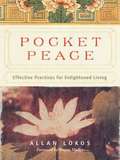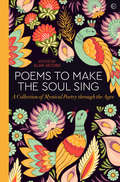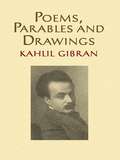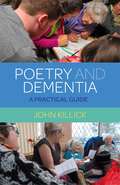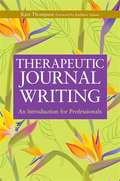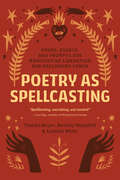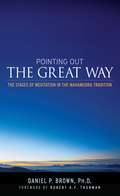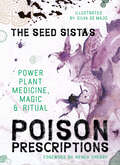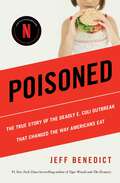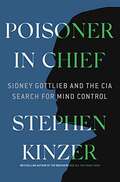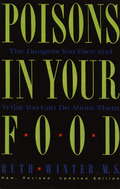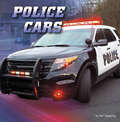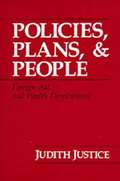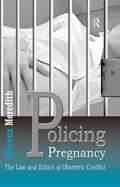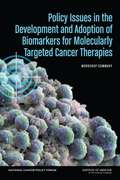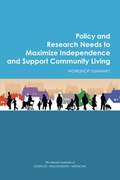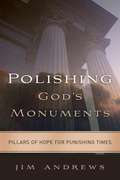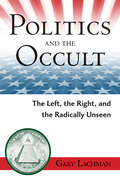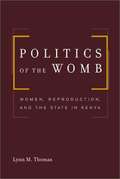- Table View
- List View
Pocket Peace: Effective Practices for Enlightened Living
by Allan LokosAn elegantly packaged "pocket-size" guide to weathering life's storms "As founder and guilding teacher of the Community Meditation Center in New York, Allan Lokos has an arsenal of tools for coping with stressful situations."—Rachel Lee Harris, New York TimesWe live in a turbulent world in which we are often forced to respond on a dime to challenging or even life-altering situations. To react wisely in difficult moments one needs to be quick on one's feet, but also quick of mind. In Pocket Peace, interfaith minister and Buddhist practitioner Reverend Allan Lokos provides readers with concise yet incisive daily "pocket practices" that will enable them to act in accordance with their truest and best selves.If you want to run a marathon, you must train slowly and purposefully for months. Likewise, if you want to be your best self and learn to confront whatever comes your way with kindness, compassion, and generosity, you need to . . . practice. This elegantly packaged little book is full of wisdom and teachings the reader can literally pull from their pocket each day. A small yet powerful spiritual companion that intertwines personal anecdotes and age-old wisdom with practical guidance, Pocket Peace sets readers on the path to inner peace and lasting happiness.
Poems to Make the Soul Sing: A Collection of Mystical Poetry through the Ages
by Alan JacobA beautifully designed collection of mystical poems to soothe, inspire and rejuvenate the soul. With a body of work spanning the centuries, from the Vedas to St Teresa of Avila, Rumi and Rilke, and arranged by transcendent themes, this book will connect readers with nature, with the stillness within themselves and with the Divine. When your soul hungers for peace, knowledge or comfort, there is no answer as profound as poetry. In a world that is increasingly noisy and disconnected from the Divine, this wonderfully inspiring collection of poems for the soul from mystics of all traditions encourages readers to listen to their own hearts, marvel at the wonder of nature and explore profound truths of life, death, eternity and God. With its elegant design and comprehensive selection of poets, the volume is ideal for gifting. Themed chapters allow readers to choose topics to explore, including: DIVINITY – what is the nature of God or the One? TRANSCENDENCE – what deep truths can we find in our spiritual quest? LOVE – how can we give and cherish most profoundly? DEVOTION – how should we explore and affirm our faith? PEACE – how can we find stillness amidst turmoil and loss? NATURE – what lessons can we learn from creation? SPIRIT – what is sacred about the individual self? From the Bhagavad Gita, the Vedas and the Song of Solomon to the Divine Comedy and the Rubaiyat of Mar Khayyam, readers will find all the great mystical writers, including Attar, Ansari, St Francis of Assisi, Lao Tzu, John Donne, John Bunyan, Gerard Manley Hopkins, Elizabeth Barratt Browning, Christine Rossetti and Walt Whitman, as well as many fine but lesser-known spiritual writers. A book to give as a thoughtful gift, and also one to treasure.
Poems, Parables and Drawings
by Kahlil Gibran Alice RaphaelThe perfect companion to Kahlil Gibran's classic, The Prophet, this elegant volume presents an original selection of works by the popular writer and artist. It consists of the complete texts and drawings of The Madman and The Forerunner, plus 20 additional illustrations--many long out of print--and a perceptive essay by art historian Alice Raphael. The Madman features a series of concise stories and verses offering uplifting views of human nature. Gibran warmly encourages his readers to abandon the superficial and embrace the true self, an outlook that recurs in The Forerunner and its 24 morality tales. Each of the poems, parables, and illustrations reflects Gibran's fervent belief in the transformative powers of love. This splendid keepsake edition of the renowned author's influential works is an ideal gift for any occasion.
Poetic Logic and the Origins of the Mathematical Imagination (Mathematics in Mind)
by Marcel DanesiThis book treats eighteenth-century Italian philosopher Giambattista Vico’s theory of poetic logic for the first time as the originating force in mathematics, transforming instinctive counting and spatial perception into poetic (metaphorical) symbolism that dovetails with the origin of language. It looks at current work on mathematical cognition (from Lakoff and Núñez to Butterworth, Dehaene, and beyond), matching it against the poetic logic paradigm. In a sense, it continues from where Kasner and Newman left off, connecting contemporary research on the mathematical mind to the idea that the products of early mathematics were virtually identical to the first forms of poetic language. As such, this book informs the current research on mathematical cognition from a different angle, by looking back at a still relatively unknown philosopher within mathematics.The aim of this volume is to look broadly at what constitutes the mathematical mind through the Vichian lens of poetic logic. Vico was among the first to suggest that the essential nature of mind could be unraveled indirectly by reconstructing the sources of its “modifications” (his term for “creations”); that is, by examining the creation and function of symbols, words, and all the other uniquely human artifacts—including mathematics—the mind has allowed humans to establish “the world of civil society,” Vico’s term for culture and civilization.The book is of interest to cognitive scientists working on math cognition. It presents the theory of poetic logic as Vico articulated it in his book The New Science, examining its main premises and then applying it to an interpretation of the ongoing work in math cognition. It will also be of interest to the general public, since it presents a history of early mathematics through the lens of an idea that has borne fruit in understanding the origin of language and symbols more broadly.
Poetry and Dementia: A Practical Guide
by John KillickPoetry is an engaging and inclusive activity for older people that can help develop memory, imagination and identity. This book provides guidance on setting up and monitoring poetry projects for people living with dementia in group care homes and individual families. It explains the benefits of creative expression for people with dementia, and shows how to facilitate poetry reading and writing groups in different environments. Specific techniques for introducing poetry to older people can be employed by family members or professional care staff to enhance the wellbeing of the individual living with dementia. The ethical issues of running poetry projects in dementia care are explored along with examples of poetry produced by individuals and groups, interviews with care workers, and case studies.
Poetry and Story Therapy: The Healing Power of Creative Expression
by Geri Giebel ChavisWords are powerful, and words matter to people. When words embody sense imagery, they conjure up visions in the imagination and affect us on a visceral level. When we embrace special words of our choosing to soothe or inspire us, they often function like a companion or a talisman. This book focuses on the act of reading word combinations found in poems and stories. It also highlights the act of writing creative pieces in response to these literary works and to a rich variety of other stimuli. This book is even more about how the acts of reading and writing personally meaningful words can act as springboards to growth and healing through the guidance and encouragement of a skilled helper.
Poetry as Spellcasting: Poems, Essays, and Prompts for Manifesting Liberation and Reclaiming Power
by Tamiko Beyer Destiny Hemphill Lisbeth WhitePoems, essays, and prompts to sing a new world into being--Queer & BIPOC perspectives on poetry as an insurgent ritual for manifesting liberation and reclaiming power.Written for poets, spellcasters, and social justice witches, Poetry as Spellcasting reveals the ways poetry and ritual can, together, move us toward justice and transformation. It asks: If ritualized violence upholds white supremacy, what ritualized acts of liberation can be activated to subvert and reclaim power?In essays from a diverse group of contributing poets, organizers, and ritual artists, Poetry as Spellcasting helps readers explore, play, and deepen their creativity and intuition as integral tools for self- and communal healing and social change. Each section opens with a poem and includes prompts that invite the reader to engage more deeply with:Portals of Inheritance: Ancestral Teachings, Possible Futures opens portals to messages from ancestors and for survivalLanguages of Liberation, Disruption, and Magic explores how poetry and spellcasting allow us to enter into and harness language in active, heightened ways that both reflect reality and manifest alternatives.Invoking Radical Imagination leans into the incantatory possibilities of poetry as prayer and poetry as enchantment.Sacred Practices: Rituals of Repair and Revision explores writing as ritual, ritual as practice, and practice as doing, drawing connections between the creative practices of poetry and spellwork.Lighting Fires, Breaking Chains focuses on the explicitly magical and political nature of poetry as spellcasting.Elemental Ecologies, Spiritual Technologies wrestles with concepts of home, colonization, and belongingBoth poetry and occult studies have been historically dominated by white, cishet writers; here, Poetry as Spellcasting reclaims the centrality of queer and BIPOC voices in poetry, magic, and liberatory spellwork.
Point Reyes Complete Guide
by Jessica LageOnly 30 miles from San Francisco, Point Reyes National Seashore attracts admirers year-round to its forests, wetlands, and beaches. Visitors come to this tranquil place to hike, camp, backpack, bike, kayak, horseback ride, picnic, fish, and nature-watch. This invaluable resource gives detailed information on the trails, roads, camps, and and beaches within the Seashore, plus surrounding parks and preserves. Point Reyes: The Complete Guide to the National Seashore & Surrounding Area has much more than coverage of all the popular recreational activities and hiking trails.
Point of Origin: Gobekli Tepe and the Spiritual Matrix for the World’s Cosmologies
by Laird ScrantonReveals Gobekli Tepe as a center of civilizing knowledge for the ancient world• Details how symbolic elements at Gobekli Tepe link a pre-Vedic cult in India to cosmological myths and traditions in Africa, Egypt, Tibet, and China• Discusses how carved animal images at Gobekli Tepe relate to stages of creation and provide an archaic foundation for symbolic written language• Defines how classical elements of ancient Egyptian myth and religion characterize an archaic cosmological tradition that links ancestrally back to Gobekli TepeHow could multiple ancient cultures, spanning both years and geography, have strikingly similar creation myths and cosmologies? Why do the Dogon of Africa and the civilizations of ancient Egypt, India, Tibet, and China share sacred words and symbols? Revealing the existence of a long-forgotten primal culture and the world’s first center of higher learning, Laird Scranton shows how the sophisticated complex at Gobekli Tepe in Turkey is the definitive point of origin from which all the great civilizations of the past inherited their cosmology, esoteric teachings, and civilizing skills, such as agriculture, metallurgy, and stone masonry, fully developed. Scranton explains how the carved images on Gobekli Tepe’s stone pillars were the precursors to the sacred symbols of the Dogon, Egyptians, Tibetans, and Chinese as well as the matriarchal Sakti cult of ancient Iran and India. He identifies Gobekli Tepe as a remote mountain sanctuary of higher knowledge alluded to in Sakti myth, named like an important temple in Egypt, and defined in ancient Buddhist tradition as Vulture Peak. Scranton reveals how Gobekli Tepe’s enigmatic “H” carvings and animal symbolism, symbolic of stages of creation, was presented as a kind of prototype of written language accessible to the hunter-gathers who inhabited the region. He shows how the myths and deities of many ancient cultures are connected linguistically, extending even to the name of Gobekli Tepe and the Egyptian concept of Zep Tepi, the mythical age of the “First Time.” Identifying Gobekli Tepe not only as the first university but also as the first temple, perhaps built as a civilizing exercise, Scranton definitively places this enigmatic archaeological site at the point of origin of civilization, religion, and ancient science.
Pointing Out the Great Way
by Robert Thurman Daniel P. BrownMany books have been published in recent years on the topic of mahamudra, or meditation on the fundamentally clear nature of the mind. This book is different in the systematic way it draws from a variety of source texts in order to construct a complete, graded path of practice informed by an understanding of the particular obstacles faced by meditators in the West. Dan Brown is a clinical psychotherapist who has also spent much time evaluating the experiences of meditators on longterm retreats. He knows the Tibetan literature on mahamudra meditation and has over thirty years of both personal meditation experience and observation of the experiences of others. He co-wrote, with Ken Wilber and Jack Engler, the book Transformations in Consciousness, and he teaches an annual seminar on mahamudra meditation at the Esalen Institute. Pointing Out the Great Way is a spiritual manual that describes the Tibetan Buddhist meditation known as mahamudra from the perspective of the 'gradual path.' The gradual path is a progressive process of training that is often contrasted to sudden realization. As such, this book contains a step-by-step description of the ways to practice, precise descriptions of the various stages and their intended realizations, and the typical problems that arise along with their remedies. Simply put, mahamudra meditation involves penetrative focus, free of conceptual elaboration, upon the very nature of conscious awareness. A unique feature of this book is its integrative approach to the stages of mahamudra meditation. A number of works on Buddhist meditation stages in general and mahamudra meditation in particular are already available in English, yet none, single text or commentary on the stages of mahamudra meditation, captures the inner experience of these stages in sufficient detail to convey its richness. This book represents the needed alternative by integrating material from a variety of root texts, practical manuals,
Poison Prescriptions: Power Plant Medicine, Magic & Ritual
by The Seed SistasPoison Prescriptions is a stunningly illustrated grimoire of some of the most notorious plants: henbane, datura, belladonna, among others. It is also a practical guide to plant magic, medicine and ritual, offering advice to professional and home herbalists, to those interested in forgotten lore and the old ways, and to all those who wish to reclaim control of their own wellbeing.This book urges the resurrection of the ancient tradition of using these witching herbs in ritual and medicine. Now is the time to relink magic and medicine in the context of modern herbalism and contemporary witchcraft.Discover: Safe ways of interacting with the witching herbs to usher in wellbeing and healing.Practical activities ranging from meditations and folklore writing to wreath making and beer brewing.Step-by-step instructions to creating the powerful witches' Flying Ointment and using it in ritual, sex magic and lucid dreaming.
Poisoned
by Jeff Benedict"Your perfect beach book has arrived. With Poisoned, Jeff Benedict manages to deliver the full literary experience of a medico-legal thriller in a work of nonfiction that, fortuitously enough, could not be more relevant to recent headlines."-The New York TimesIn this riveting work of narrative nonfiction, award-winning journalist and best-selling author Jeff Benedict chronicles the events surrounding the biggest food-poisoning epidemic in US history and how this unprecedented crisis sparked public awareness about unsanitary practices in the fast food industry. Poisoned draws on access to confidential documents and exclusive interviews with the real-life characters at the center of the drama.Jeff Benedict is considered one of America's top nonfiction writers. He is the author of nine books including bestsellers Little Pink House, Without Reservation, and Pros and Cons. His reporting has been the basis of feature segments on 60 Minutes, ABC's 20/20, Dateline NBC, HBO's Real Sports with Bryant Gumbel, and the Discovery Channel. He is a contributor to Sports Illustrated and the Deseret News, and his articles have been published in The New York Times, Los Angeles Times, Newsweek, and the Hartford Courant. He has a law degree and is a distinguished professor of English at Southern Virginia University.
Poisoned Profits
by Philip Shabecoff Alice ShabecoffIn this shocking and sobering book, two fearless journalists directly and definitively link industrial toxins to the current rise in childhood disease and death. In the tradition of Silent Spring,Poisoned Profitsis a landmark investigation, an eye-opening account of a country that prizes money over children’s health. With indisputable data, Philip Shabecoff and Alice Shabecoff reveal that the children of baby boomers–the first to be raised in a truly “toxified” world–have higher rates of birth defects, asthma, cancer, autism, and other serious illnesses than previous generations. In piercing case histories, the authors identify the culprit as corporate pollution. Here are the stories of such places as Dickson, Tennessee, where babies were born with cleft lips and palates after landfill chemicals seeped into the water, and Port Neches, Texas, where so many graduates of a high school near synthetic rubber and chemical plants contracted cancer that the school was nicknamed “Leukemia High. ” The danger to our children isn’t just in the outside world, though. The Shabecoffs provide evidence that our homes are now infested with everything from dangerous flame retardants in crib mattresses to harmful plastic softeners in teething rings to antibiotics and arsenic in chicken–additives that are absorbed by growing and physically vulnerable kids as well as by pregnant women. Compounding the problem are chemical corporations that sabotage investigations and regulations, a government that refuses to police these companies, and corporate-hired scientists who keep pertinent secrets massaged with skewed data of their own. Poisoned Profitsalso demonstrates how people are fighting back, whether through grassroots parents’ groups putting pressure on politicians, the rise of “ecotheology” in the pulpits of formerly indifferent churches, or the new “green chemistry” being practiced in labs to replace bad elements with good. The Shabecoffs also include helpful tips on reducing risks to children in how they eat and play, and in how parents clean and maintain their homes. Powerful, unflinching, and eminently readable,Poisoned Profitsis a wake-up call that is bound to inspire talk and force change. From the Hardcover edition.
Poisoned: The True Story of the Deadly E. Coli Outbreak That Changed the Way Americans Eat
by Jeff BenedictNOW A NETFLIX DOCUMENTARY From Jeff Benedict, the #1 New York Times bestselling author of Tiger Woods and The Dynasty, Poisoned chronicles the events surrounding the worst food-poisoning epidemic in US history: the deadly Jack in the Box E. coli infections in 1993.On December 24, 1992, six-year-old Lauren Rudolph was hospitalized with excruciating stomach pain. Less than a week later she was dead. Doctors were baffled: How could a healthy child become so sick so quickly? After a frenzied investigation, public-health officials announced that the cause was E. coli O157:H7, and the source was hamburger meat served at a Jack in the Box restaurant. During this unprecedented crisis, four children died and over seven hundred others became gravely ill. In Poisoned, award-winning investigative journalist and #1 New York Times bestselling author Jeff Benedict delivers a jarringly candid narrative of the fast-moving disaster, drawing on access to confidential documents and exclusive interviews with the real-life characters at the center of the drama—the families whose children were infected, the Jack in the Box executives forced to answer for the tragedy, the physicians and scientists who identified E. coli as the culprit, and the legal teams on both sides of the historic lawsuits that ensued. Fast Food Nation meets A Civil Action in this riveting account of how we learned the hard way to truly watch what we eat.
Poisoner In Chief: Sidney Gottlieb And The Cia Search For Mind Control
by Stephen KinzerThe bestselling author of All the Shah’s Men and The Brothers tells the astonishing story of the man who oversaw the CIA’s secret drug and mind-control experiments of the 1950s and ’60s. The visionary chemist Sidney Gottlieb was the CIA’s master magician and gentlehearted torturer―the agency’s “poisoner in chief.” As head of the MK-ULTRA mind control project, he directed brutal experiments at secret prisons on three continents. He made pills, powders, and potions that could kill or maim without a trace―including some intended for Fidel Castro and other foreign leaders. He paid prostitutes to lure clients to CIA-run bordellos, where they were secretly dosed with mind-altering drugs. His experiments spread LSD across the United States, making him a hidden godfather of the 1960s counterculture. For years he was the chief supplier of spy tools used by CIA officers around the world. Stephen Kinzer, author of groundbreaking books about U.S. clandestine operations, draws on new documentary research and original interviews to bring to life one of the most powerful unknown Americans of the twentieth century. Gottlieb’s reckless experiments on “expendable” human subjects destroyed many lives, yet he considered himself deeply spiritual. He lived in a remote cabin without running water, meditated, and rose before dawn to milk his goats. During his twenty-two years at the CIA, Gottlieb worked in the deepest secrecy. Only since his death has it become possible to piece together his astonishing career at the intersection of extreme science and covert action. Poisoner in Chief reveals him as a clandestine conjurer on an epic scale.
Poisons in Your Food
by Ruth WinterThis classic Crown book is back with all of Ruth Winter's original, thorough research about dangerous foods and what consumers can do to protect themselves.
Police Cars (Wild About Wheels)
by Keli SipperleyLights flash and sirens sound! A police car is on its way! Police cars keep our roads and neighborhoods safe. Police cars are fast and carry equipment for fighting crime. Young readers will find out about police cars, their main parts, and how these important vehicles are used.
Policies, Plans, and People: Foreign Aid and Health Development
by Judith JusticeJudith Justice uses an interdisciplinary approach to show how anthropologists and planners can combine their expertise to make health care programs culturally compatible with the populations they serve.
Policing Pregnancy: The Law and Ethics of Obstetric Conflict
by Sheena MeredithAre pregnant women entitled to the same rights of self-determination and bodily integrity as other adults? This is the fundamental question underlying recent high-profile legal interventions in situations when pregnant women and healthcare staff do not agree on management options or appropriate behaviour. Courts on both sides of the Atlantic have sometimes answered that they are not, and the law has at times been manipulated to enforce compliance with medical recommendations. This is the first book of its kind to offer a comprehensive assessment of healthcare law as applied to the unique situation of pregnancy. Drawing on case material from both the UK and the USA, it describes the trend towards 'policing pregnancy' and explores the emergence of the concept of 'maternal-foetal conflict' - and why, in the author's view, this would be more appropriately labelled 'obstetric conflict'. Suggestions are made for alternative approaches that better safeguard the overall well-being of pregnant women and their future children.
Policy Issues in the Development and Adoption of Biomarkers for Molecularly Targeted Cancer Therapies: Workshop Summary
by Sharyl J. NassA long-held goal in oncology has been to develop therapies that target the specific abnormalities in each patient's cancer rather than simply treating cancers based on the tissue of origin. In the past decade, advances in technology have enabled researchers to relatively quickly and inexpensively determine, in minute detail, the genetic makeup of tumors. Although relatively few targeted cancer therapies are currently available in the clinic and it is not yet clear whether all cancers are driven by genetic changes that can be targeted, there is widespread optimism in the cancer community that this new ability to assess the genetic abnormalities in tumors will ultimately lead to better cancer treatments and improved patient outcomes. "Policy Issues in the Development and Adoption of Biomarkers for Molecularly Targeted Cancer Therapies" is the summary of a workshop convened in November 2014 by the Institute of Medicine's National Cancer Policy Forum to discuss recent trends in the development and implementation of molecularly targeted cancer therapies and explore potential policy actions to address specific challenges. This report highlights the presentations and discussions at the workshop.
Policy and Research Needs to Maximize Independence and Support Community Living: Workshop Summary
by Engineering Medicine National Academies of SciencesLiving independently and participating in one’s community are priorities for many people. In many regions across the United States, there are programs that support and enable people with disabilities and older adults to live where they choose and with whom they choose and to participate fully in their communities. Tremendous progress has been made. However, in many cases, the programs themselves – and access to them – vary not only between states but also within states. Many programs are small, and even when they prove to be successful they are still not scaled up to meet the needs of the many people who would benefit from them. The challenges can include insufficient workforce, insufficient funding, and lack of evidence demonstrating effectiveness or value. To get a better understanding of the policies needed to maximize independence and support community living and of the research needed to support implementation of those policies, the National Academies of Sciences, Engineering, and Medicine convened a public workshop in October 2015. Participants explored policies in place that promote independence and community living for older adults and people with physical disabilities, and identified policies and gaps in policies that can be barriers to independence and the research needed to support changing those policies. This report summarizes the presentations and discussions from the workshop.
Polio: An American Story
by David M. OshinskyAll who lived in the early 1950s remember the fear of polio and the elation felt when a successful vaccine was found. Now David Oshinsky tells the gripping story of the polio terror and of the intense effort to find a cure, from the March of Dimes to the discovery of the Salk and Sabin vaccines - and beyond. Here is a remarkable portrait of America in the early 1950s, using the widespread panic over polio to shed light on our national obsessions and fears. Drawing on newly available papers of Jonas Salk, Albert Sabin and other key players, Oshinsky paints a suspenseful portrait of the race for the cure, weaving a dramatic tale centered on the furious rivalry between Salk and Sabin. Indeed, the competition was marked by a deep-seated ill will among the researchers that remained with them until their deaths. The author also tells the story of Isabel Morgan, perhaps the most talented of all polio researchers, who might have beaten Salk to the prize if she had not retired to raise a family. As backdrop to this feverish research, Oshinsky offers an insightful look at the National Foundation for Infantile Paralysis, which was founded in the 1930s by FDR and Basil O'Connor. The National Foundation revolutionized fundraising and the perception of disease in America, using "poster children" and the famous March of Dimes to raise hundreds of millions of dollars from a vast army of contributors (instead of a few well-heeled benefactors), creating the largest researchand rehabilitation network in the history of medicine. The polio experience also revolutionized the way in which the government licensed and tested new drugs before allowing them on the market, and the way in which the legal system dealt with manufacturers' liability for unsafe products. Finally, and perhaps most tellingly, Oshinsky reveals that polio was never the raging epidemic portrayed by the media, but in truth a relatively uncommon disease. But in baby-booming America - increasingly suburban, family-oriented, and hygiene-obsessed - the specter of polio, like the specter of the atomic bomb, soon became a cloud of terror over daily life. Both a gripping scientific suspense story and a provocative social and cultural history, Polio opens a fresh window onto postwar America.<P><P> Pulitzer Prize Winner
Polishing God's Monuments: Pillars of Hope for Punishing Times
by Jim AndrewsPolishing God's Monuments is the true story of a young woman and her devoted husband who face it all (and then some) as a baffling, mind-boggling illness hijacks their youth and shatters their dreams. Polishing God's Monuments blends straightforward theology with the account of this young couple's afflictions. A sober reality in the life of faith is that "through many tribulations we must enter the kingdom of God." God's people are buffeted in two ways: sometimes we suffer for the faith and other times we suffer with faith. Either way, our faith remains a work in progress. In the midst of troubles, our emotions can vacillate between hope and despair, submission and rebellion. Our understanding can alternate between moments of comprehension and times of total confusion. This book confronts these issues head-on and offers believers biblical perspective, practical direction, and sustaining hope.
Politics and the Occult: The Left, the Right, and the Radically Unseen
by Gary LachmanThe gritty business of politics is not something we usually associate with the occult. But esoteric beliefs have influenced the destiny of nations since the time of ancient Egypt and China, when decisions of state were based on portents and astrology, to today, when presidents and prime ministers privately consult self-proclaimed seers. Politics and the Occult offers a lively history of this enduring phenomenon. Author and cultural pundit Gary Lachman provocativly questions whether the separation of church and state so dear to modern political philosophy should be maintained. A few of his fascinating topics include the fate of the Knights Templar and the medieval Gnostic Cathars, the occult roots of America and the French Revolution in Freemasonry, Gurdjieff and the swastika, Soviet interest in UFOs, the CIA and LSD, the Age of Aquarius, the millenarian politics that inform the struggle with Islamic terrorism, fundamentalism, and more.
Politics of the Womb: Women, Reproduction, and the State in Kenya
by Lynn M. ThomasIn more than a metaphorical sense, the womb has proven to be an important site of political struggle in and about Africa. By examining the political significance--and complex ramifications--of reproductive controversies in twentieth-century Kenya, this book explores why and how control of female initiation, abortion, childbirth, and premarital pregnancy have been crucial to the exercise of colonial and postcolonial power. This innovative book enriches the study of gender, reproduction, sexuality, and African history by revealing how reproductive controversies challenged long-standing social hierarchies and contributed to the construction of new ones that continue to influence the fraught politics of abortion, birth control, female genital cutting, and HIV/AIDS in Africa.
